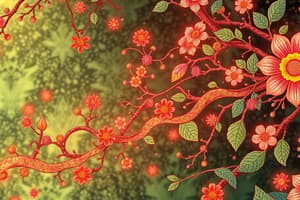Podcast
Questions and Answers
What is the significance of a positive ΔG in a chemical reaction?
What is the significance of a positive ΔG in a chemical reaction?
- It signifies an endergonic reaction that requires energy input. (correct)
- It represents a state of equilibrium between reactants and products.
- It means the reaction can proceed without any additional energy.
- It indicates the reaction occurs spontaneously.
Which statement correctly describes enthalpy (ΔH)?
Which statement correctly describes enthalpy (ΔH)?
- It quantifies the amount of energy absorbed or released in a reaction. (correct)
- It represents the energy available for doing work in a system.
- It measures the change in randomness of a system.
- It is the difference between free energy and entropy.
In the equation ΔG = ΔH - TΔS, what does T represent?
In the equation ΔG = ΔH - TΔS, what does T represent?
- Total energy content of the reactants.
- The pressure of the system at standard conditions.
- The energy required to initiate a reaction.
- Temperature in Kelvin. (correct)
What does a ΔG of zero imply about a chemical reaction?
What does a ΔG of zero imply about a chemical reaction?
Which condition is NOT part of the standard states for evaluating bioenergetics?
Which condition is NOT part of the standard states for evaluating bioenergetics?
What does entropy (ΔS) measure in a chemical reaction?
What does entropy (ΔS) measure in a chemical reaction?
How is the free energy (G) of a system maintained under constant conditions?
How is the free energy (G) of a system maintained under constant conditions?
Which of the following correctly defines an endergonic reaction?
Which of the following correctly defines an endergonic reaction?
Which expression provides a measure of useful work obtainable from a thermodynamic system?
Which expression provides a measure of useful work obtainable from a thermodynamic system?
Which of the following is a factor that delineates the direction of chemical reactions?
Which of the following is a factor that delineates the direction of chemical reactions?
What does the sign of ΔG indicate about a biochemical reaction?
What does the sign of ΔG indicate about a biochemical reaction?
Which statement correctly describes ΔG°?
Which statement correctly describes ΔG°?
What is the primary concern of bioenergetics in biological systems?
What is the primary concern of bioenergetics in biological systems?
Which term describes a reaction with a negative ΔG?
Which term describes a reaction with a negative ΔG?
How does a decrease in free energy (ΔG) affect the feasibility of a chemical reaction?
How does a decrease in free energy (ΔG) affect the feasibility of a chemical reaction?
Which factor is NOT directly measured by kinetic parameters in biochemical reactions?
Which factor is NOT directly measured by kinetic parameters in biochemical reactions?
What does a standard free energy change (ΔG°) of a reaction represent?
What does a standard free energy change (ΔG°) of a reaction represent?
In a biochemical context, what does the term 'exergonic' imply?
In a biochemical context, what does the term 'exergonic' imply?
What is the primary role of ATP as an energy carrier in biological systems?
What is the primary role of ATP as an energy carrier in biological systems?
Which scenario allows a pathway to potentially proceed despite the presence of a +ΔG in some individual reactions?
Which scenario allows a pathway to potentially proceed despite the presence of a +ΔG in some individual reactions?
What is the primary condition under which ΔG° is a useful predictor of reaction direction?
What is the primary condition under which ΔG° is a useful predictor of reaction direction?
How does ATP hydrolysis contribute to biochemical pathways with a large +ΔG?
How does ATP hydrolysis contribute to biochemical pathways with a large +ΔG?
Which of the following statements about enzyme activity is true?
Which of the following statements about enzyme activity is true?
Which of these statements about ΔG and reaction coupling is accurate?
Which of these statements about ΔG and reaction coupling is accurate?
In what condition does ΔG° remain unchanged?
In what condition does ΔG° remain unchanged?
What is a consequence of having large +ΔG reactions in a pathway?
What is a consequence of having large +ΔG reactions in a pathway?
Which of the following describes a common intermediate in sequential reactions?
Which of the following describes a common intermediate in sequential reactions?
What is the fundamental role of R, T, and Keq in the context of ΔG°?
What is the fundamental role of R, T, and Keq in the context of ΔG°?
When can we say that a biological reaction is likely to proceed spontaneously?
When can we say that a biological reaction is likely to proceed spontaneously?
What is primarily indicated by a depletion of the adenine nucleotide pool in relation to cellular damage?
What is primarily indicated by a depletion of the adenine nucleotide pool in relation to cellular damage?
Which therapy aims to limit the size of an infarction during a cardiac event?
Which therapy aims to limit the size of an infarction during a cardiac event?
What is a significant consequence of oxidative phosphorylation depression during ischemia?
What is a significant consequence of oxidative phosphorylation depression during ischemia?
Which factor is NOT listed as a predisposing factor for atherosclerosis?
Which factor is NOT listed as a predisposing factor for atherosclerosis?
What is the primary cause of lipid peroxidation during oxidative stress?
What is the primary cause of lipid peroxidation during oxidative stress?
What is the primary damaging effect of free radicals during ischemia?
What is the primary damaging effect of free radicals during ischemia?
What does the symbol ΔG° indicate in relation to ATP?
What does the symbol ΔG° indicate in relation to ATP?
Which statement about equilibrium in chemical reactions is true?
Which statement about equilibrium in chemical reactions is true?
What role does ATP play in energy transfer within cells?
What role does ATP play in energy transfer within cells?
Which of the following is a characteristic of very high-energy phosphate compounds?
Which of the following is a characteristic of very high-energy phosphate compounds?
What is the significance of the ΔG° value of -7300 cal/mol for ATP?
What is the significance of the ΔG° value of -7300 cal/mol for ATP?
Which enzyme type is primarily responsible for transferring phosphate groups in energy metabolism?
Which enzyme type is primarily responsible for transferring phosphate groups in energy metabolism?
How does the reaction N-P + ATP → N-P-P + ADP contribute to cellular energy dynamics?
How does the reaction N-P + ATP → N-P-P + ADP contribute to cellular energy dynamics?
In the context of ΔG° and Keq, what is the meaning of a negative ΔG° value?
In the context of ΔG° and Keq, what is the meaning of a negative ΔG° value?
What is the relationship between energy-rich intermediates and ATP synthesis?
What is the relationship between energy-rich intermediates and ATP synthesis?
Which of the following statements best describes the role of kinetically stable reactions in ATP turnover?
Which of the following statements best describes the role of kinetically stable reactions in ATP turnover?
Flashcards are hidden until you start studying
Study Notes
Overview of Bioenergetics
- Bioenergetics involves the transfer and utilization of energy within biological systems.
- Focuses on initial and final energy states of reactions and predicts feasibility.
- Changes in free energy (ΔG) indicate whether a reaction can occur spontaneously.
Standard State Conditions
- Standard conditions for bioenergetics include:
- pH = 7
- Temperature = 25°C (288°K)
- Solute concentrations at 1M
- Gases at 1 atmospheric pressure
Free Energy Concepts
- Free energy (G) reflects the usable energy available for work in a system.
- ΔG can be positive (endergonic, non-spontaneous), negative (exergonic, spontaneous), or zero (equilibrium).
- Key components impacting ΔG include:
- Enthalpy (ΔH): relates to heat content changes in reactions.
- Entropy (ΔS): indicates randomness or disorder changes.
Calculating ΔG
- ΔG = ΔH - TΔS where T is temperature in Kelvin.
- ΔG of a metabolic pathway can be additive; a series of reactions can proceed if the overall ΔG is negative, even if some reactions have positive ΔG.
ATP as an Energy Carrier
- ATP hydrolysis helps drive energetically unfavorable reactions by coupling them with spontaneous processes.
- The ΔG° of ATP is approximately -7300 cal/mol for each of its two terminal phosphate groups, indicating its high energy potential.
- Reactions involving ATP can convert energy-rich intermediates into ATP through phosphorylation.
Electron Transport Chain (ETC) and Oxidative Phosphorylation
- The electron transport chain facilitates ATP synthesis and is dependent on oxygen.
- A cessation in mitochondrial ATP synthesis can lead to increased ADP and depletion of energy stores.
Ischemia and Reperfusion Case Study
- Ischemia refers to insufficient blood supply, often caused by thrombus or plaque.
- Key diagnostic measures include clinical history, ECG, and biomarkers like CK-MB and Troponin levels.
- Treatment aims to prevent cardiac arrhythmias and limit myocardial damage through interventions such as t-PA (thrombolysis).
Superoxide Metabolism and Reperfusion Injury
- Superoxide is a reactive species formed during electron transport and can lead to oxidative damage.
- Reperfusion injury is characterized by cell membrane damage and infiltration of calcium, which disrupts cellular environments.
- Free radicals generated can cause lipid peroxidation, DNA damage, and protein oxidation, contributing to cellular deterioration.
Atherosclerosis Risk Factors
- Main contributors to atherosclerosis include elevated LDL, cholesterol, low HDL, smoking, and hypertension.
- Strategies for long-term management involve dietary adjustments and medications such as HMG-CoA reductase inhibitors to mitigate risk factors.
Studying That Suits You
Use AI to generate personalized quizzes and flashcards to suit your learning preferences.




